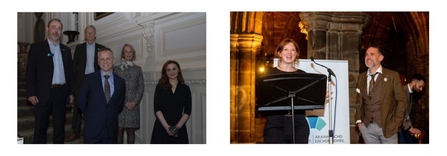In the halls of Pavilions in the Blue Zone of the 26th UN Climate Change Conference of Parties (COP26) the first Peatland Pavilion stood out as one of only a handful of thematic pavilions and one which offered a welcoming, accessible and informative space – thanks to the global peatland community.
Between the 1st – 12th November the Peatland Pavilion hosted a truly hybrid programme of events. The iconic ‘Water Droplet’ installation, designed by Richard Lindsay (University of East London) and erected by a dedicated build team (Jack Clough, Julie Van Offelen and Sarah Proctor), welcomed Cabinet Secretaries, Ministers, civil servants, peatland experts, SEC staff and pavilion visitors from across the UK and internationally whilst our online platform, powered by CrowdComms, connected 1,705 participants from 100 different countries into 45 live-streamed sessions. All sessions will be available to watch via a dedicated Peatland Pavilion YouTube channel later in December.





